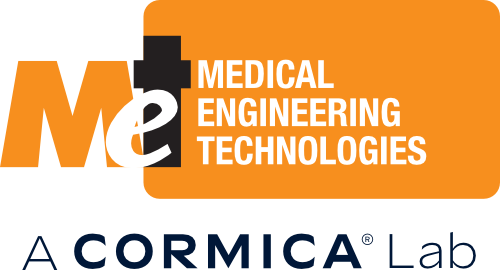How is vacuum decay used in pharma CCIT and packaging integrity testing?
USP 1207 Closed Container Integrity Testing can be performed using a Vacuum Pressure Decay method. The method is also suitable for leak testing of impermeable medical device packaging.
Vacuum pressure decay is a deterministic integrity test for closed containers. A digital pressure / vacuum leak tester is used to create a vacuum in a slave chamber. When the vacuum is produced the pump is isolated and the vacuum is connected to the test chamber. The test chamber must fit the test part very closely to minimise space (and therefore dilution of the vacuum). After a stabilisation period of a few seconds the pressure in the test chamber is monitored for up to 10 seconds. Any reduction in vacuum will be the result of a leak from the closed container into the test chamber.
The product designer and risk analysis should specify test pressures and allowed leak rate. MET then develops an appropriate the test programme. Verification is made using a calibrated leak which plugs into the test circuit. This manufactured calibrated leak is verified using a soap bubble test and electronic calibration. It is a needle valve.
Tool Manufacture and Confirmation
When the test chamber has been made an IQ can be performed and the test method can be perfected.
Tool commissioning protocol - Assembly, integrity test and ability to detect a leak.
1. Make a close fitting two-part tool to fit the sealed container under test (for example a pre-filled syringe).
2. Minimise all space in the tool.
3. Open and close tool and test for leaks (-0.9 bar for 1 minute)
4. Repeat 10 times.
5. Open and close tool and test for leaks (-0.1 bar for 1 minute)
6. Repeat 10 times.
7. Report tool number, and integrity test results.
8. Close tool with calibrated leak in system and test for leaks (-0.9 bar for 1 minute).
9. Repeat 10 times.
10. Report tool number, calibrated leak details and test results.
Process development protocol
1. Put a known to be good product into the tool.
2. Check that no leak is present.
3. Introduce the calibrated leak into the system.
4. Develop test programme by adjusting: evacuation time and pressure, stabilisation time, test time.
5. Once programme established with the correct leak identified record the test details
Protocol IQ, Installation Protocol (tooling)
This protocol can be conducted using a manufactured calibrated leak or with a product with a perforation of known size.
1. Test 5 products that have no leak 10X each without calibrated leak - ensure correct result.
2. Test products that have no leak 10X each with calibrated leak - ensure correct result.
3. Report tool number, calibrated leak number, process details and test results.
Protocol, Performance Qualification (Tooling)
The OQ and PQ are combined in a Gauge Reliability and Repeatability process. This protocol should be repeated on different occasions by the same operator and by other operators. The ideal qualification regime is three operators each following the protocol on three occasions each.
It should be repeated for each tool / product combination.
1. Put a known good PFS into the tool.
2. Check no leak.
3. Introduce the calibrated leak into the system.
4. Run programme and record leak measured.
5. Repeat process on 10 samples.
6. Report tool number, calibrated leak number, process details and test results
7. All technicians and iterations must report statistically equivalent results.
This qualification process refers to the tooling. The process for the test control and measuring equipment will vary according to the design of that equipment.
Talk to the Medical Engineering Technologies team to discuss your leak testing needs.
